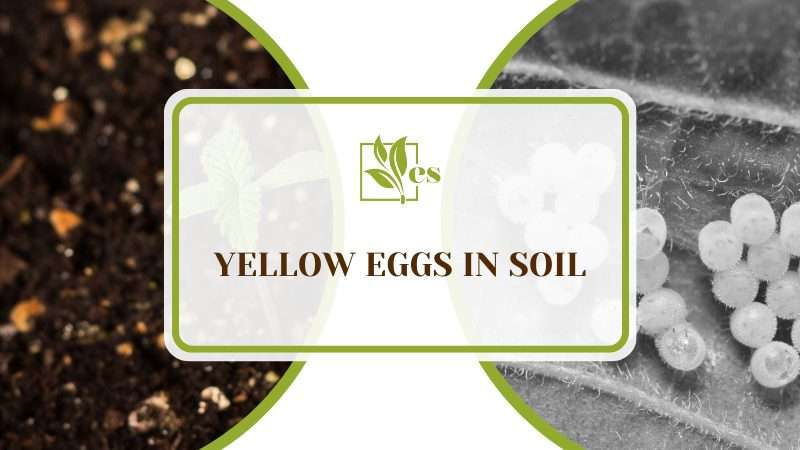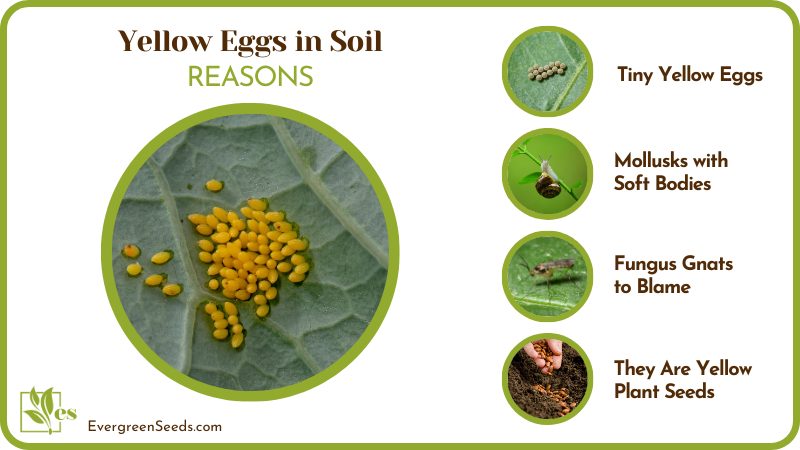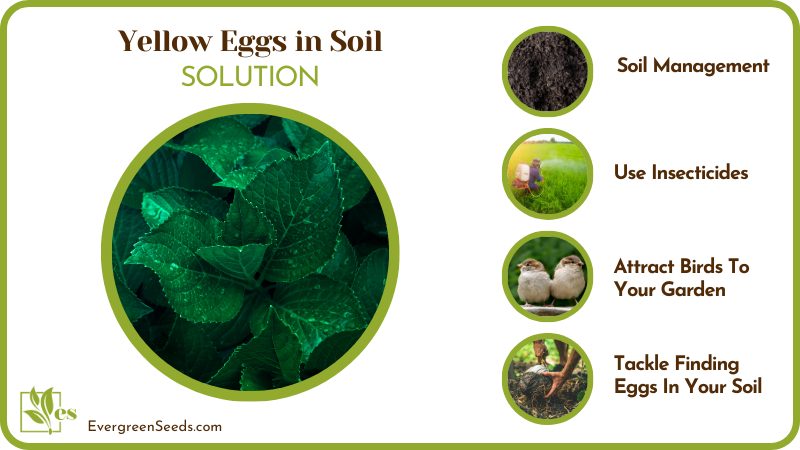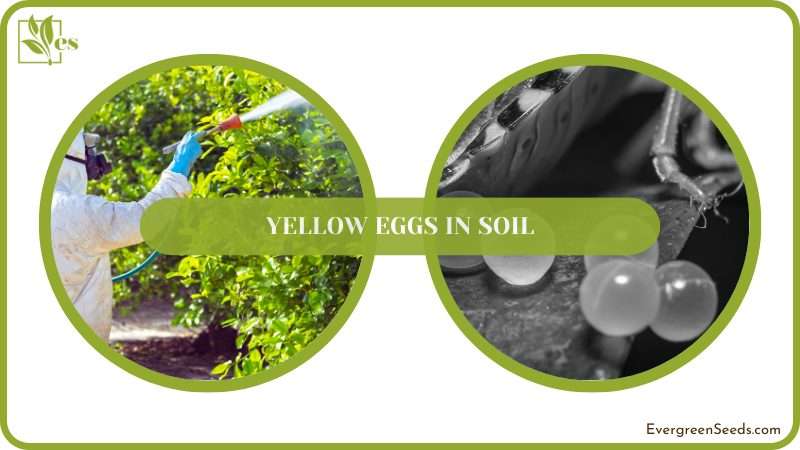Yellow eggs in soil can be a menace – as they are usually insect eggs. You must maintain healthy soil for your plants for them to flourish properly, so it is crucial to treat the soil promptly.

Insects that deposit their eggs in the soil can surely be detrimental to the well-being of your plants. In this article, we go over what these yellow eggs or balls in your soil can mean, so continue reading to discover how to spot and eliminate insect eggs in the soil.
Yellow Eggs In Soil: What Can They Be?
Yellow eggs in soil mostly have one of two explanations – fertilizer or insect eggs. Insect eggs typically lack a unique hard outer covering and are significantly smaller than fertilizer pellets. Insect eggs feel somewhat gooey and sticky to the touch. They might sometimes be spherical, but can also be elongated.
In addition, unlike fertilizer balls evenly distributed throughout the soil, insect eggs are localized in one location. You can move them using a stick or other instrument. If they appear to be of the same size, hard and dry, you can relax – it is fertilizer. To further confirm your suspicions, you can break them using a stick or tool.

Although insect eggs and fertilizer undoubtedly fall under the category of “yellow balls,” you might also encounter other yellow balls in your soil. It can be other items – tiny yellow bugs, plant seeds, or even spider eggs.
– Tiny Yellow Eggs
It makes sense to assume that yellow eggs are bug eggs since most insects begin as eggs. However, insect eggs often change size and color as they age, so they are only little and yellow at certain times.
Insect eggs can be any color, including white, yellow, brown, and shades of all of them. How they are laid matters; certain insect eggs are placed separately, while others are clustered (typically joined together with some kind of “glue”). Insect eggs are most likely clumped together. If the yellow balls are dispersed, you can almost always assume they are fertilizer.
– Fertilizer
Due to its remarkably similar appearance to bug eggs in size, shape, and color, it is not uncommon for amateur gardeners to mistake fertilizer for insect eggs that may cause harm to beloved plants.
Fertilizers may unknowingly be discarded because eggs can cause alarm bells for new gardeners, causing them to panic if they spot fertilizer in their soil and mistake it for insect eggs. Granular fertilizer, on the other hand, is typically quite tiny and not pliable.
Granular fertilizer doesn’t necessarily have a yellow hue. It is frequently white or brown. What distinguishes granulated fertilizer from insect eggs, then? The test of pressing. Granular fertilizer is difficult to handle, and pressing it won’t alter its structure. It might split apart if you squeeze it hard enough, but no liquid will come out.
– Mollusks with Soft Bodies
Remember that clumps of eggs do not always indicate the presence of insects; they could also indicate the presence of slugs or snails. To recognize insect eggs, remember that they can vary in size and color and appear separately or in clusters. They are also pliable; try pressing an egg with your thumb and index finger, which should collapse (and probably crack) under pressure.
– Insect Eggs That Have Dropped From Leaves
Bugs likely placed their eggs on leaves rather than in the soil, and the larvae were quite possibly knocked to the ground by wind, rain, or a passing animal. In addition, various beetle, moth, spider, and aphid species deposit their eggs on leaves.
These eggs are small, spherical, and pale in color, the same as eggs produced in the soil, and they frequently have an adhesive substance on them that attaches them to the blade. If you locate any, test them using the pressing test; they will respond similarly to soil eggs.
– Aphids
Aphid eggs may be present if you see a colony of eggs on the foliage of a houseplant. They typically place them on a leaf’s underside. The elliptical eggs have either been glued to the blade or strung together with thread to secure them.
Like most insects, aphid eggs are pale in color but eventually, turn dark. Some aphid eggs eventually turn entirely black; many are coated in wax-like material that repels predators. Aphid eggs may mature in as little as ten days, exposing you to a new population of pests in your home, so you must act quickly if you want to get rid of them from your soil.
It is very difficult to identify the type of aphid from the eggs alone. Eggs play little or no part in the taxonomic keys. There is only a small number of egg-related terminologies.
– Beetles
Every beetle lays eggs, yet not every beetle’s egg is the same. Though members in the Cupedidae group lay hard eggs, most insect eggs are soft. From one species to another, egg features and egg-laying techniques differ.
While some beetles produce only a few eggs, others produce enormous clusters. Various eggs range in size from little to enormous. Some are pink, white, or yellow. In addition, some beetles wrap their eggs into leaves to protect them, while others lay their eggs beneath leaves.
All beetles evolve into offspring, which are the ones that pose a threat to your plants. The ability to develop requires that larvae feed almost continuously between meals. The larvae will consume your plant’s foliage if the egg hatches into your plant’s soil.
Some larvae, like the Hercules beetles, develop to rather large sizes; therefore, their appetites are almost insatiable. Beetles must be eliminated when they are still eggs if you don’t want your flower to be devoured. Due to how quickly they hatch, this normally takes as little as four days but can take as long as 19 days. Eggs can be very small to quite large. You can add some plants that repel beetles to get a bug free garden.
– Moths
Similar to how beetles reproduce, moths can lay up to a thousand eggs at once. Moths also lay clusters of eggs, which they can do directly on stems or branches, on leaves, or, less frequently, on the soil. These eggs eventually hatch into caterpillars which then later will turn into moths.
As soon as the caterpillars hatch, they must consume plant matter to grow. Therefore, moths will undoubtedly eat and possibly destroy your plant if they lay their eggs there and are allowed to stay. As a result, many moth species are seen as pests – of either crops or vegetable gardens.
– Other Insects
Armyworms are common vegetable worms, and their adult form are moths. This is a destructive insect and should be eradicated.
Ladybugs are other insects that lay small yellow eggs. These insects are considered beneficial. They have a close relative, the Mexican bean beetle, that is actually a pest. Their eggs look very similar, but it’s much easier to tell the difference once the larvae have hatched.
Ladybugs are seen as beneficial because they prey on certain pests, such as aphids. One ladybug can eat up to 5,000 insects in its lifetime. Therefore you should be certain you are not destroying their eggs if you find them.
Cabbage loopers have very small yellow-white eggs. The eggs can be as small as 0.017 inches and are usually found on the underside of leaves. When found, it is advisable to remove them as cabbage loopers are harmful.
Spider mite eggs only become yellow in later stages. Spider mites are also harmful to your plant. If you find any yellow eggs in the soil, it is wise to check the leaves to ensure you don’t have a pest on your hands.
– Fungus Gnats To Blame
Due to their constant proximity to the soil, fungus gnats are regarded as pests. Although their damage to seedlings is rumored, they are known to feed as larvae on fungi that develop on soil; therefore, getting rid of them is crucial.
Although these insects don’t threaten mature, healthy plants, they show something is wrong with the plant. For instance, root decay attracts them. So you can have root rot if you notice fungus gnats around your plant. However, they can be quickly eliminated by adding mulch and sand around the plants, pulling out any sick roots, using better-draining soil in their place, and watering them less frequently.
– Ants Are the Problem
Ants can harm adult plants, and red immigrant fire ants in Florida are a common cause of this issue. Even if the tree is just an adult tree, ants might eat the bark if a colony grows nearby. This will cause lesions to emerge on the tree, which will then allow parasites to grow. It’s crucial to eliminate them immediately because this could potentially result in tree death. In some cases, you might find some black bugs in the soil and you may confuse them with ants.
– Yellow Plant Seeds
There are many yellow, rounded seeds, like rapeseed and yellow mustard seeds, to name only a few. This could lead you to believe that seeds are insect eggs. To distinguish between seeds and bug eggs, look for hard seeds that cannot be smashed by pressing, just like fertilizer.
– Eggs of a Spider In Plant Soil
Spiders can produce up to three thousand eggs, frequently woven into webs. Although it is conceivable for spiders to lay their eggs underground, since they prefer to stay above ground, you are much more likely to locate eggs on the flower itself.
If they are above ground, they will be much safer from predators, and they are excellent climbers. Therefore, although it is reasonable, destroying these arachnids’ eggs is unnecessary because they pose no threat to your plants.
How To Remove Insect Eggs From Soil
To remove insect eggs from the soil, the best technique is to scoop them out after ensuring they are insects rather than fertilizer or seeds. If they are created in clusters, this is very simple. Clusters are also a sign that they are eggs rather than something else.

Suppose they are dispersed, and you cannot remove them individually. Another option is to rinse the soil with a solution that combines 3 percent hydrogen peroxide with water (1:4). Your plants will not be harmed, but all of the eggs will undoubtedly be destroyed.
– Soil Management
You can use soil management to get rid of these eggs. The first step – especially for fungus gnats – is to isolate the plant that seems to be contaminated. Insects that have already laid eggs are very likely to keep on laying eggs in nearby plants’ soil.
After that, you can dry out the soil. That would be the top 1.5 inches. Don’t worry – you can still water your plant using the draining holes at the bottom.
– Use Insecticides
If you need help determining what kind of insects you’re dealing with, broad-spectrum pesticides are an excellent option. But using an insecticide meant for a particular species reduces the possibility of hurting unintended insects like beetles, moths, and flatworms.
Please ensure your insecticides won’t hurt your dogs because they could become poisoned from consuming plant foliage. Before purchasing, you can swiftly and readily find this information on the labels provided by pesticide producers.
The different pesticides include spraying, gelling, dusting, and baits. Regardless of their shape, each has a label with instructions on how to utilize it. Do not deviate from those directions since pesticides can be harmful, even fatal, to humans, animals, and children if swallowed.
– Neem Oil
Neem oil is an excellent, more natural choice to kill off insect eggs. Use two tablespoons of neem oil and two to three teaspoons of mild liquid soap to a gallon of water. Spray the solution once every week for two to three weeks. Make sure that the neem oil is not expired.
– Attract Birds To Your Garden
Another excellent approach to keep insects at bay is to allow good predators like birds into your property. You may rely on insects to maintain the health of your soil because many animals eat insects. It’s different when you have pests in potted plants, particularly houseplants, as you can’t let birds fly about your house. If this is the case, turn to alternative techniques.
You can expose bugs to parasitoids or diseases in addition to predators. You can infect bugs with parasitoids and allow the parasitoids to kill the insects because there are specific parasitoids for different insect species. The particular bug species must be positively identified for this to function, as not all parasitoids are effective on all species of insects.
– Use Pathogens
One reliable strategy for permanently removing insects from an area is to use pathogens like bacteria, fungi, and viruses. Applying particular bacteria and viruses to plants may be a long-term remedy for bug infestations because they only kill insects.
Remember that novices shouldn’t deal with parasitic organisms or pathogens without consulting experts to risk killing your plant or injuring yourself and your pets.
– Tackle Finding Eggs In Your Soil
To prevent the eggs from hatching and harming your plants, you can simply remove them by hand if you believe you have discovered them in potting soil or the soil surface in your containers. Another, more drastic option is to remove the dirt from your potted plant completely.
 Why? Since insects are tiny, plucking all the eggs may not be enough reason to move elsewhere (they might move on to a new location and start a new nest from scratch).
Why? Since insects are tiny, plucking all the eggs may not be enough reason to move elsewhere (they might move on to a new location and start a new nest from scratch).
If the eggs are from worms – which are helpful creatures – consider whether you can move them outside so they can grow in the soil there. Again, it is advised that you put on gloves as a precaution.












